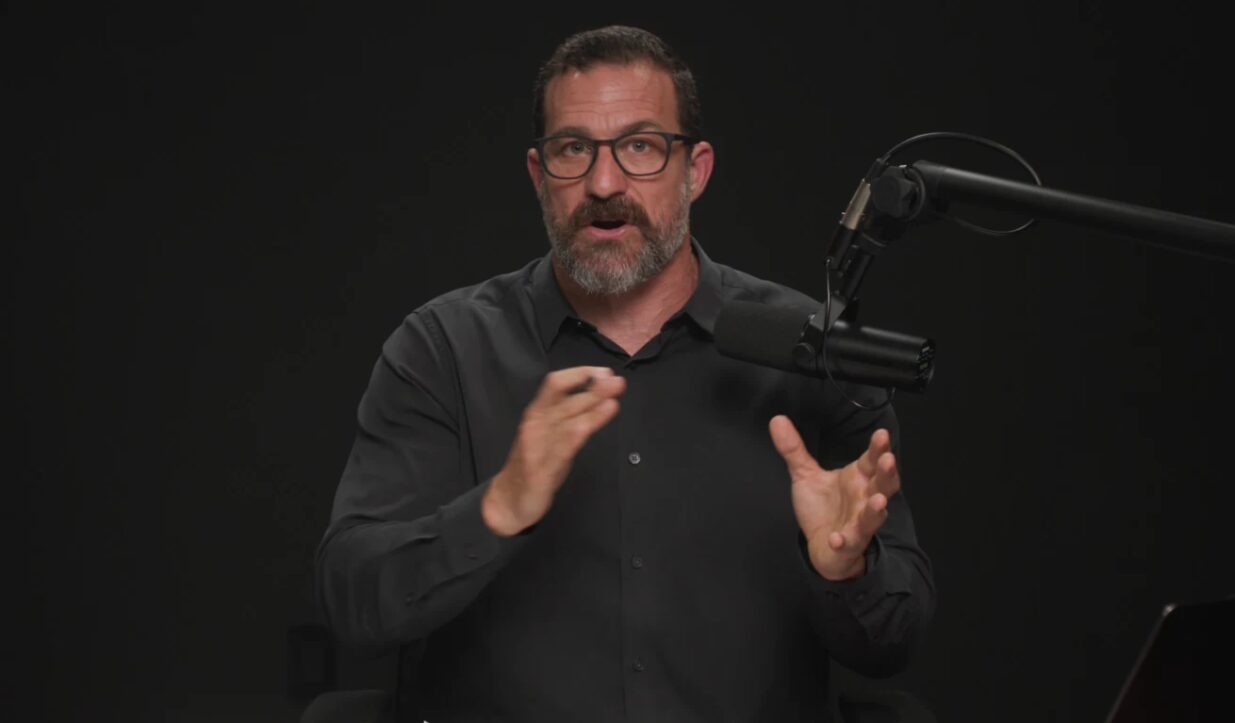Joe Rogan, host of the world’s most popular podcast with over 11 million listeners per episode, revealed a deceptively simple health hack that he’s heard could be “like a life changer” for back pain and spinal health.
In his latest episode (#2390) with Jack Carr, retired Navy SEAL and bestselling thriller author, Rogan opened up about his personal fitness wake-up call and the daily practice he’s currently testing to transform his physical health.
The 90-Second Protocol He’s Testing
“I do it every day. I do a minute and 30 seconds every day,” Rogan revealed during the October 7, 2025 episode. “I’ve decided to try this to see like what it does like for my back. Like because it decompresses your back. And I’ve heard that if you just do it every day, it’s like a life changer.“
The practice? Dead hanging from a pull-up bar—a technique where you simply grip a bar and let your body weight decompress your spine.
Rogan is currently 10 days into this experiment: “So I’m like 10 days in now. 10 days of every day. Minute 30 I hang,” he explained.
But Rogan, ever the honest commentator, admitted the practice isn’t easy: “At that minute and 20, I got to check the phone,” he confessed, revealing that those final 10 seconds are mentally challenging enough that he needs a distraction to push through.
The 57-year-old podcaster, comedian, and UFC commentator has long been vocal about his fitness routines, martial arts training, and biohacking experiments. But this revelation came alongside a more vulnerable admission about his recent struggles with body image and fitness consistency.
The Wake-Up Call Moment
Rogan discussed experiencing a jarring reality check after seeing photographs of himself from a June 2025 visit that prompted him to recommit to his health goals.
“We took a picture together and I saw it and I’m like, ‘Oh, oh my gosh, I look horrible. I so out of shape,’” Rogan admitted. He explained this wasn’t even at his worst: “By late August or no, late July, that was about six years of not doing anything“.
His honest admission about seeing an unflattering photo and needing to recommit to health goals resonates with listeners who often view celebrities and influencers as immune to such struggles.
The Science Behind Dead Hanging
While Rogan’s experiment with this practice has generated interest among his massive audience, dead hanging has independently gained traction in physical therapy and fitness communities for legitimate biomechanical reasons.
Dead hanging creates spinal decompression by allowing gravity to gently stretch the spine, potentially providing relief from compression that builds up throughout the day from sitting, standing, and poor posture. The practice can:
- Improve grip strength and forearm endurance
- Decompress the spine and create space between vertebrae
- Stretch the shoulders and lats
- Strengthen the core through stabilization
- Improve shoulder mobility and health
Physical therapists often recommend hanging exercises for patients with chronic back pain, though they emphasize proper form and gradual progression—starting with shorter durations and building up to 90 seconds or more as Rogan is testing.
Why 90 Seconds Matters
The specific duration Rogan mentioned—one minute and 30 seconds—aligns with recommendations from spine health experts who suggest that meaningful spinal decompression requires sustained hanging time. Brief 10-20 second hangs primarily build grip strength, while hanging for 60-90 seconds or longer allows the spine to fully elongate and decompress.
However, achieving even 90 seconds of continuous dead hanging requires significant grip strength and shoulder stability, which explains why Rogan—despite his extensive martial arts background and fitness regimen—still finds those final seconds mentally taxing enough to need a phone check as motivation.
The Relatable Fitness Struggle
What makes Rogan’s revelation particularly compelling is the vulnerability behind it. Despite access to world-class trainers, state-of-the-art facilities, and deep knowledge of fitness protocols from thousands of hours interviewing health experts, he’s not immune to the same body image concerns and fitness plateaus that affect millions of Americans.
His candid admission about six years of inconsistent fitness and feeling “horrible” and “out of shape” makes his wellness journey more credible and relatable than typical celebrity health content.
The Jack Carr Connection
The episode with Jack Carr provided the perfect context for health and fitness discussions. Carr, whose thriller novels draw from his 20 years as a Navy SEAL, brings firsthand experience with elite military fitness standards and the physical demands of special operations.
The conversation touched on Carr’s latest novel “Cry Havoc,” his upcoming Amazon Prime series “True Believer,” and his previous show “The Terminal List” starring Chris Pratt—all of which feature intense physical training and combat sequences.
Part of a Larger Wellness Pattern
This revelation comes as Rogan continues featuring functional medicine and longevity experts on his podcast. His late September episode with Brigham Buhler, founder of Ways2Well regenerative clinic, exemplifies his ongoing interest in cutting-edge health optimization and sustainable wellness practices.
The hanging protocol represents Rogan’s preference for simple, consistent practices over complex biohacking interventions—a philosophy he’s increasingly emphasized as he approaches his 60s.
Implementing the Protocol Safely
For listeners inspired to try Rogan’s hanging experiment, fitness experts recommend:
Start gradually: Begin with 10-20 second hangs and build up over weeks or months
Use proper grip: Hands should be shoulder-width apart with a full grip on the bar
Engage shoulders: Don’t let shoulders completely relax; maintain slight engagement to protect the joint
Bend knees if needed: For those unable to hang with straight legs, bending knees reduces total body weight
Listen to your body: Stop if you experience sharp pain in shoulders, elbows, or wrists
Consistency over duration: Daily practice matters more than achieving long hang times immediately
Those with pre-existing shoulder injuries, rotator cuff issues, or spinal conditions should consult with a healthcare provider before attempting hanging exercises. Importantly, people with spinal instability should avoid hanging and decompression exercises entirely. Spinal instability occurs when specific segments of your spine have excessive motion, creating micro-movements that trigger pain—particularly when rolling over in bed, bending forward, or during twisting movements. If you experience sharp pain that worsens after hanging attempts, or feel a “catching” or “locking” sensation during movement, you may have instability rather than compression-type back pain, and hanging could worsen your condition rather than help it.
The Power of Micro-Habits
Rogan’s 90-second daily hanging experiment exemplifies the power of micro-habits—small, sustainable practices that compound over time. In an era of elaborate morning routines and complex supplement stacks promoted by wellness influencers, a simple 90-second practice stands out for its accessibility.
The fact that one of podcasting’s biggest voices—someone with unlimited resources and access to the world’s top health experts—is openly testing such a straightforward practice validates the principle that effective health optimization doesn’t require complexity.
Beyond the Hang: Rogan’s Holistic Approach
While the hanging protocol captured attention, it’s just one component of Rogan’s broader health philosophy that includes:
- Regular sauna sessions (he’s a longtime proponent of heat therapy)
- Consistent martial arts training (primarily Brazilian Jiu-Jitsu)
- Bowhunting and outdoor activity
- Targeted supplementation
- Prioritizing sleep and recovery
- Daily movement and mobility work
His willingness to share both his experimentation process and struggles—like admitting he needs to get back in shape after six years of inconsistency—makes his health advice more credible and relatable than typical celebrity wellness content.
The Verdict
Joe Rogan’s revelation about his daily 90-second hanging experiment offers a fascinating real-time case study: celebrity endorsement of a practice backed by sound biomechanical principles, wrapped in relatable vulnerability about fitness struggles.
Whether you’re a devoted JRE listener or simply someone dealing with back pain and looking for sustainable solutions, the hanging protocol represents an accessible starting point that requires nothing more than a pull-up bar and 90 seconds of daily commitment.
As Rogan demonstrated, even the most challenging final 10 seconds become manageable with a small mental hack—checking your phone to distract from the discomfort.
In a wellness landscape often dominated by expensive interventions and complex protocols, Rogan’s experiment with this simple “life-changing” habit serves as a reminder that sometimes the most effective health practices are also the simplest—though only 10 days in, time will tell if it lives up to its reputation.



















